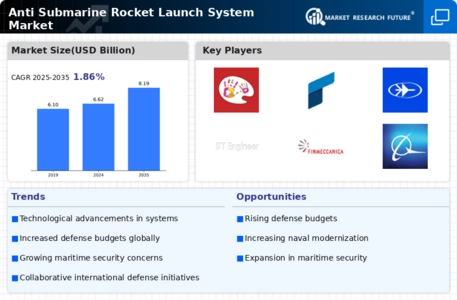Multi-Role Platforms
The trend towards multi-role platforms is reshaping the Anti Submarine Rocket Launch System Market. Modern naval vessels are increasingly designed to perform various functions, including anti-submarine warfare, surface combat, and air defense. This versatility allows for more efficient resource allocation and operational flexibility. As navies seek to maximize their capabilities, the demand for integrated systems that can address multiple threats simultaneously is on the rise. Reports indicate that the market for multi-role naval platforms is projected to grow, with anti-submarine systems being a critical component of these platforms. This trend suggests a shift towards comprehensive naval strategies that prioritize adaptability.
Geopolitical Tensions
Geopolitical tensions are a driving force in the Anti Submarine Rocket Launch System Market. Nations are increasingly aware of the threats posed by submarine warfare, particularly in contested maritime regions. The rise of state-sponsored submarine fleets has prompted countries to bolster their anti-submarine capabilities. Recent military exercises and strategic partnerships among nations indicate a heightened focus on naval defense. This environment fosters a competitive market landscape, where countries are likely to invest heavily in advanced anti-submarine systems to ensure national security. The market is expected to respond positively to these geopolitical dynamics, with increased procurement budgets allocated for defense.
Increased Defense Budgets
Increased defense budgets across various nations are significantly impacting the Anti Submarine Rocket Launch System Market. Governments are recognizing the necessity of investing in advanced military technologies to counter emerging threats. This trend is particularly evident in regions with heightened maritime disputes, where nations are prioritizing their naval capabilities. Recent data indicates that defense spending is expected to rise by an average of 3% annually, with a substantial portion allocated to anti-submarine warfare systems. This financial commitment is likely to drive innovation and procurement in the market, fostering a competitive environment for manufacturers and suppliers.
Technological Advancements
The Anti Submarine Rocket Launch System Market is experiencing a surge in demand due to rapid technological advancements. Innovations in sonar technology, missile guidance systems, and launch mechanisms are enhancing the effectiveness of anti-submarine warfare. For instance, the integration of artificial intelligence in targeting systems is expected to improve accuracy and response times. As nations invest in modernizing their naval capabilities, the market is projected to grow significantly, with estimates suggesting a compound annual growth rate of over 5% in the coming years. This trend indicates a shift towards more sophisticated and efficient systems, which could redefine naval warfare strategies.
Environmental Considerations
Environmental considerations are becoming increasingly relevant in the Anti Submarine Rocket Launch System Market. As nations develop and deploy anti-submarine systems, there is a growing awareness of the ecological impact of military operations. This has led to the exploration of more sustainable technologies and practices within the industry. For instance, the development of quieter and less environmentally damaging propulsion systems is gaining traction. Additionally, regulatory frameworks are evolving to address these concerns, potentially influencing procurement decisions. The market may see a shift towards systems that not only meet operational requirements but also align with environmental sustainability goals.


















Leave a Comment